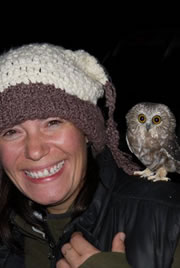Deep freeze frogs
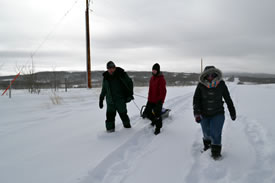
Pulling the heavy sled (Photo by NCC)
It’s a chilly day in March when we meet with Dave Prescott, Alberta Fish and Wildlife species at risk biologist, amidst snow drifts and icicles at the Twin Butte General Store. Despite the weekend blizzard and challenging road conditions, Dave has driven down from Red Deer, hauling his son Ian along for the ride, for the sole purpose of assisting the Nature Conservancy of Canada (NCC) in a new endeavour. It is here in the Waterton Park Front (WPF), home of Alberta’s megafauna species of bears, elk and cougars, that we are on the hunt for something truly huge — northern leopard frogs.
Yes, you read that right — we are searching for frogs in the middle of winter, or more accurately, for appropriate sites for frog reintroduction.

Northern leopard frog (Photo by Barb Houston)
Thanks to generations of ranching and the surrounding community’s ongoing commitment to good stewardship practices, conservation is not just a word along the WPF; it’s a way of life. This is exemplified by the fact that of the suite of species’ existing prior to settlement of this area, just two are largely no longer present on the landscape — the bison (other than a demonstration herd in Waterton Lakes National Park) and the northern leopard frog. While the demise of the bison is well documented and known, for many Albertans the plight of the northern leopard frog has gone unnoticed, despite its handsome appearance with large black spots surrounded by pale halos and a distinctive pair of white ridges along its sides.
The reasons for the frog’s disappearance in most of its former Alberta range aren’t clear. But up to just a few decades ago they were an important part of ecosystems here, consuming insects themselves and falling prey to the likes of American badgers and sandhill cranes. Their amphibious natures also provide important links, such as the transfer of nutrients, between riparian (wetlands, creeks, etc.) and upland habitats.
With Dave’s support and as part of NCC’s continued commitment to protecting and improving native species diversity, we hope that 2014 reintroduction efforts on NCC-owned property in the WPF will return the northern leopard frog to this corner of its former range throughout the plains. Which is why, despite the cold grip of winter, we had ventured out of our warm offices into the wild on this particular day — we needed to determine whether dissolved oxygen levels at potential reintroduction sites give a green light to reintroduction efforts this spring.
The frogs spend the winter under the ice of rivers, creeks or ponds. But they need to have adequate dissolved oxygen to survive.
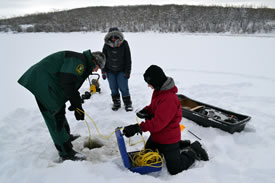
Measuring the diffused oxygen in the pond (Photo by NCC)
Back at the site, we aren't able to reach our first site by vehicle (so much snow!), so we make our way on foot. Armed with a dissolved oxygen meter, an ice auger and other equipment on a heavily-laden sled that becomes increasingly heavier as we trudge along, a snow-filled trail brings us ever closer to a site where northern leopard frogs were historically observed.
The air is crisp against our cheeks and the snow crunches with each step, until finally we arrive at our destination — an ice- and snow-covered pond.
After making our way to the middle of the pond and a few (or more) tugs on the pull cord, the ice auger roars to life and in excitement we gather in close to watch Dave and Ian drill a hole through the ice. We quickly draw back again as the ice falls away and an overwhelming musk of fermenting pond water hits us — the smell is simply awful! But soldiering on in the name of conservation we each bury our noses into our scarves and before long the sensor is lowered into the icy waters. We wait with patient impatience, anxious to see if the final numbers are indicative of appropriate oxygen levels.
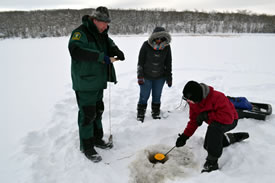
High tech tools (Photo by NCC)
With great disappointment, we watch the numbers plummet and Dave announces that the pond is unsuitable for frogs to overwinter in. But we brighten with the promise of a nearby creek, which could offer suitable overwintering habitat to frogs who breed in this pond.
With renewed vigour, we begin the long hike back to our vehicles with plans to try there. To our great surprise as we approach the crest of a hill, it seems as though our vehicles have disappeared, and two moose seem to have replaced them! They saunter into the trees, seeming to not even notice us as we soldier on toward our next potential frog site.
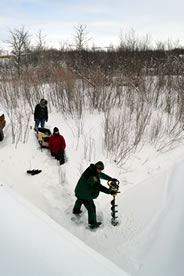
Drilling hole in creek (Photo by NCC)
Our next stop is a nearby creek. It seems like an excellent potential overwintering location. As one would imagine, running water typically contains higher dissolved oxygen than standing water. With measured excitement, we once again watch the ticking numbers on Dave’s dissolved oxygen meter. This time we're pleased to hear the site is satisfactory for overwintering frogs, making the pond we just visited a candidate for potential frog reintroduction this spring.
After a subtle, but suitable, “hoppy” dance and animated conversation regarding future partnership and other potential sites to consider further in the spring, we bid Ian and Dave a fond farewell.
This is a small but significant step towards helping the northern leopard frog once again call NCC’s WPF home. As we drive away, we feel hopeful for the frogs and grateful for the partnership of Alberta Fish and Wildlife. Once this long winter really makes way for spring, we will be conducting further habitat assessments and searching for egg masses to relocate to the WPF.
Stay tuned!
Written by Wonnita Andrus in collaboration with Kim Pearson.

